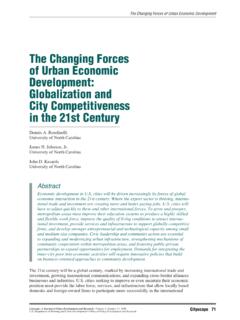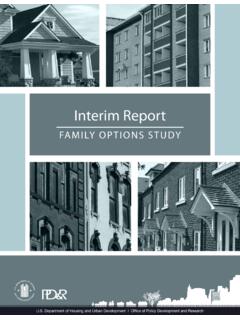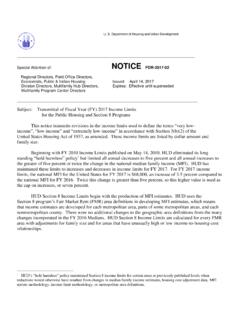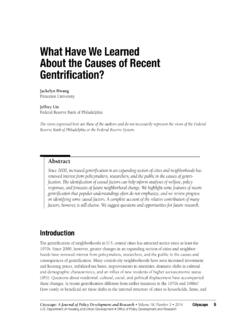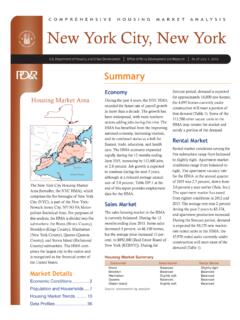Transcription of Community Empowerment Strategies - HUD USER
1 Community Empowerment Strategies Cityscape 121 Cityscape: A Journal of Policy Development and Research Volume 2, Number 2 May Department of Housing and Urban Development Office of Policy Development and ResearchCommunity EmpowermentStrategies: The Limits andPotential of Community Organizingin Urban NeighborhoodsPeter DreierOccidental CollegeAbstractThis article focuses on the factors that lead to successful Community organizing, Community -based development, and Community -based ser-vice provision are distinct Community Empowerment Strategies . Community organiz-ing centers on mobilization of residents to address common problems.
2 While manymacroeconomic and social structural factors can promote or inhibit grassroots mobi-lization, this discussion emphasizes the importance of leadership development, strate-gic planning, and network building (across neighborhoods, cities, and regions) inmobilizing people to solve their common problems. The major obstacle to successfulcommunity organizing is the lack of training in leadership development and organi-zational capacity building. The primary strategy recommended for overcoming thisobstacle is to help Community organizations take advantage of intermediary organi-zations such as organizing networks and training centers that have emerged duringthe past several the late 1970s, the Nation has witnessed a remarkable resurgence of citizen activ-ism.
3 Residents of America s urban neighborhoods have ignited what Harry Boyte calleda backyard revolution of Community activism (Boyte, 1980, 1989; Berry et al., 1993).Most American cities, and many inner-ring suburbs, have at least some level of grassrootsneighborhood participation. Today, tens of thousands of neighborhood organizations areinvolved in a wide range of Community improvement is important to distinguish among three Strategies for promoting what is often calledcommunity Empowerment . Community organizing involves mobilizing people to combatcommon problems and to increase their voice in institutions and decisions that affect theirlives and communities.
4 Community -based development involves neighborhood-basedefforts to improve an area s physical and economic condition, such as the construction orrehabilitation of housing and the creation of jobs and business enterprises. Community -based service provision involves neighborhood-level efforts to deliver social servicesDreier122 Cityscape(such as job training, child care, parenting skills, housing counseling, immunization, andliteracy) that will improve people s lives and opportunities (often called human capital )within a heart of the new Community Empowerment movement is grassroots organizing tosolve social problems and improve economic conditions in distressed urban neighbor-hoods.
5 Community organizations that engage in successful mobilization efforts some-times branch out into Community development and/or the provision of social efforts to balance these components are not without tension, this is a logical steptoward a comprehensive Community Empowerment agenda. Community groups that focusprimarily on service delivery or Community development often lose the energy and mo-mentum required to do effective Community organizing. Service delivery and communitydevelopment are more effective when they are part of a Community organizing strategy,especially when the tasks are clearly delineated within the organization (Traynor, 1993;Miller, 1992; Lenz, 1988).
6 For example, in a number of cities, ACORN (a national network of Community organiza-tions) has drawn on its success in challenging bank redlining to become involved in hous-ing counseling for potential homeowners. In Lowell, Massachusetts, the Coalition for aBetter Acre began as an affiliate of Massachusetts Fair Share, a citizen action group; afterseveral years of successful organizing around neighborhood issues, the group formed itsown Community development corporation (CDC) to repair and build affordable Brooklyn Churches, a coalition of New York City religious congregations that ispart of the Industrial Areas Foundation (IAF) network, spent a decade working on neigh-borhood issues before establishing its own housing development program (NehemiahHomes)
7 , which has become one of the largest nonprofit development projects in organizations vary widely in size, scope, and competence, but the range ofissues and concerns that have been addressed is remarkable. They include public safety,crime, and drugs; tenants rights, abandoned housing, and housing discrimination; envi-ronmental and public health issues, such as toxic waste dumping, smoking, lead paint, andpollution; Community reinvestment, redlining, and related matters; economic develop-ment, job training, and plant closings; youth, education, and recreation; and municipalservices delivery. Some Community organizations focus on a single issue, while otherstackle a variety of issues under a single organizational umbrella.
8 Some groups focussolely on problems on their block or in their neighborhood, while others tackle issuesacross neighborhoods, either by expanding their own turf or by forging alliances andcoalitions with counterparts in other experiences and activities of the Nation s Community -based Empowerment organiza-tions provide ample evidence that the American self-help tradition is alive and many Americans engage in some aspect of Community organizing, the publicis not well informed about this phenomenon. The mainstream media typically report onthe activities of these groups only when they disrupt business as usual.
9 Few newspapers ortelevision stations routinely cover the efforts of Community -based organizations (Dreier,May 1991, September/October 1993). Although funding organizations and some scholarshave examined specific groups, there has been relatively little analysis of the experiencesof these groups or of the factors that account for their success. Still, there is a sufficientbody of knowledge about this growing sector of American urban life to provide a briefoverview of recent trends and an evaluation of the factors that contribute to their successor Empowerment Strategies Cityscape 123 The Federal Role in Community EmpowermentIn recent years, many government officials, civic leaders, and academics have embracedthe notion of Community Empowerment as a component of a strategy for revitalizingand strengthening America s urban communities.
10 To do so makes sense from both amoral and an administrative perspective. In a democracy, self-government rests on twofoundations: citizen participation and reciprocal responsibility. Community empowermentreflects the longstanding American values of promoting strong families in healthy neigh-borhoods, self-help and volunteerism, and the balancing of rights and , if government Community development programs are to succeed, social institu-tions in America s neighborhoods must be strengthened. Community Empowerment isconsistent with the concept, endorsed by both conservatives and liberals, of using volun-tary intermediary Community institutions to help rebuild the social fabric or social capi-tal of troubled Neither the public nor the private sector alone canaddress the problems of America s urban areas; Community organizations must play a keyrole.
